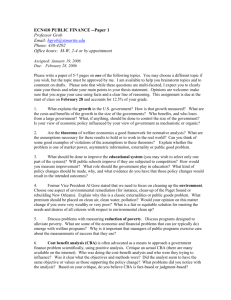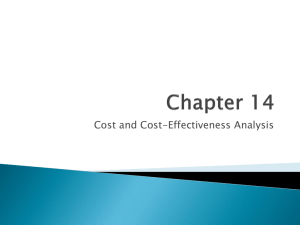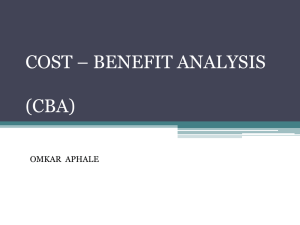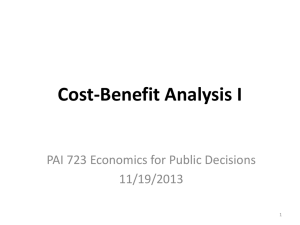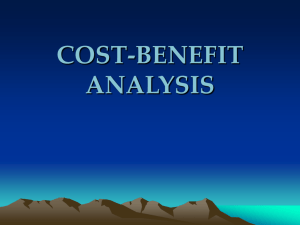cba as a method for seeking efficiency
advertisement
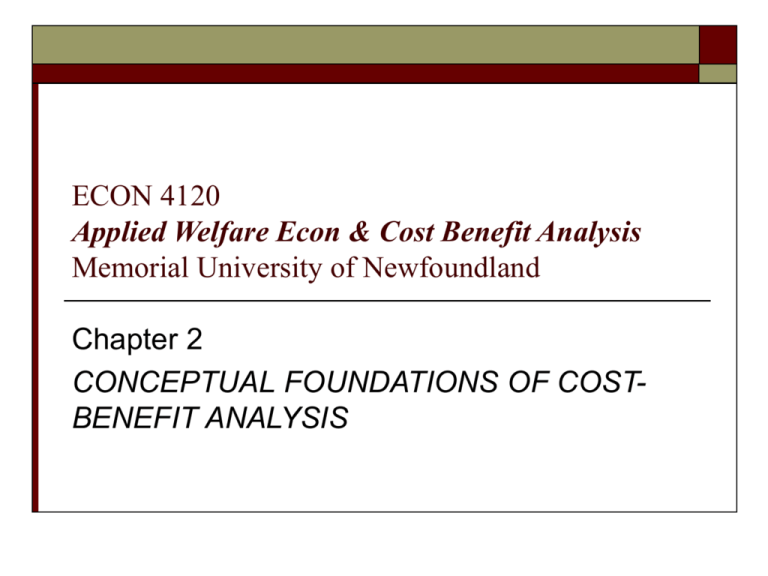
ECON 4120 Applied Welfare Econ & Cost Benefit Analysis Memorial University of Newfoundland Chapter 2 CONCEPTUAL FOUNDATIONS OF COSTBENEFIT ANALYSIS CBA AS A METHOD FOR SEEKING EFFICIENCY Allocative efficiency: Resources are deployed in their highest valued use in terms of the goods and services they create CBA AS A METHOD FOR SEEKING EFFICIENCY Pareto efficiency: An allocation of goods is Pareto efficient if no alternative allocation can make at least one person better off without making anyone else worse off CBA can be used to provide information about the relative efficiency of alternative policies CBA AS A METHOD FOR SEEKING EFFICIENCY The Pareto rule is biased towards the status quo (gives veto power to one person) but the HicksKaldor criterion is based on potential Pareto improvements In that sense it only sanctions win-win situations, which are of course very rare It makes the rule very “sterile” CBA AS A METHOD FOR SEEKING EFFICIENCY A Pareto rule is biased towards the status quo (gives veto power to one person) but the Hicks-Kaldor criterion is based on potential Pareto improvements Net Benefits and Pareto Efficiency The link between net benefits and Pareto efficiency is straightforward: if net benefits are positive, then it is possible to find a set of transfers that makes at least one person better off without making anyone else worse off. CBA AS A METHOD FOR SEEKING EFFICIENCY Willingness to Pay (WTP) is the payment that one would have to make or receive (WTA) under the policy so one would be indifferent between the status quo and the policy with the payments. The algebraic sum of the WTP values is the appropriate measure of the net benefits of the impacts of a policy. If and only if the aggregate net benefits of the policy (as measured by WTP of affected individuals) are positive, then there exists a set of contributions and payments that make a Pareto improvement over the status quo. CBA AS A METHOD FOR SEEKING EFFICIENCY Willingness to Pay (WTP) is the payment that one would have to make or receive (WTA) under the policy so one would be indifferent between the status quo and the policy with the payments. We cannot measure utility, and it is just an ordinal measure, but WTP gives us a way to measure in a cardinal way how individuals feel about a policy CBA AS A METHOD FOR SEEKING EFFICIENCY Willingness to Pay (WTP) is the payment that one would have to make or receive (WTA) under the policy so one would be indifferent between the status quo and the policy with the payments. We no longer need to make interpersonal comparisons of welfare It is only individuals themselves who need to consider their own utility and how much money they need to feel compensated for a policy change or would be willing to pay for it CBA AS A METHOD FOR SEEKING EFFICIENCY Opportunity Cost places a dollar value on inputs required to implement policies. The opportunity cost of an input is its value in its best alternative use Using CBA for Decision Making If all impacts are valued using WTP and all inputs are valued using opportunity costs, then the sign of net benefits indicates if it is possible to increase Pareto efficiency. However, using a decision rule to implement only Pareto efficient policies is impractical for the following reasons: The information burden of measuring benefits and costs for each individual. The administrative burden of actually making each required transfer. Compensation would induce people to overstate costs and understate benefits. Potential Pareto Efficiency (i.e. Kaldor-Hicks criterion) Alternative decision rule: Adopt only policies that have positive net benefits. Reasons for adopting it: It is feasible. Society maximizes aggregate wealth. If different policies have different winners and losers, then, in aggregate, costs and benefits will average out over the entire population. It counters incentive to give too much weight to organized groups and too little weight to unorganized groups. It is possible to do redistribution wholesale rather than within each separate policy. Application of the Decision Rule in Practice Adopt all policies that have positive net benefits (if all policies are independent) If policies interfere or enhance each other, choose the combination of policies that maximizes net benefits. Application of the Decision Rule in Practice Benefit-Cost Ratio = Benefit/Cost The benefit/cost ratio can confuse choice: Does one choose the policy with the best ratio or the highest net benefits? One should generally choose the policy with the largest net benefits because the ratio can be manipulated (i.e., is something a negative benefit or a positive cost?). Care must be taken to determine interactions among projects so that combinations of projects providing the greatest aggregate net benefits can be identified (i.e., find interferences and synergies). MAIN ISSUES RELATED TO WTP Theoretical Limitations of WTP as Basis for Social Orderings The rule for creating a social ranking of alternatives is not fully satisfactory. Arrow’s Theorem (AT): K. Arrow (1951) proved that any social choice rule that satisfies a basic set of fairness conditions could produce illogical results. The conditions are: Individuals may have any transitive preferences (axiom of unrestricted domain). If alternative1 is unanimously preferred by all individuals over alternative 2, then alternative 2 should not be chosen (axiom of Pareto choice). The ranking of two alternatives should not depend on what other alternatives are available (axiom of independence of irrelevant alternatives). No one person should have dictatorial power (axiom of non-dictatorship). MAIN ISSUES RELATED TO WTP Arrow’s Theorem states that any rule that satisfies all four conditions will fail to ensure a transitive social ordering of policy alternatives Therefore, the net benefits rule needs to violate at least one axiom if it is always to produce a transitive social ordering of policies In order to ensure the use of WTP in implementing the potential Pareto principle will produce a transitive ordering of policies, assumptions (violating the axiom of unrestricted domain) must be placed on individual preferences (i.e., the utility function of individuals must be such that the individual demand functions that they imply can be aggregated into a market demand curve that has the sum of individual incomes as an argument) Also, all individuals must see the same prices. MAIN ISSUES RELATED TO WTP Also, compensating variation (a commonly used measure of WTP) can produce Scitovsky reversals Scitovsky reversals result when the sum of compensating variations for a group of individuals is positive for a move from one Pareto-efficient policy to another and from the new policy back to the original Therefore, the sum of compensating variation being positive is a necessary but not sufficient condition for a potential Pareto improvement One can avoid these theoretical problems by assuming policies affect only the price of a single good (i.e., assume away price effects in the markets for other goods). MAIN ISSUES RELATED TO WTP Dependence of WTP on Distribution of Wealth The WTP of a person depends on the wealth of the individual => if the distribution of wealth of society changes, then individual WTP changes, and perhaps, the ranking of alternatives could change Dependence of net benefits on distribution of wealth is not a problem if losers are actually compensated (a la Pareto principle) In the potential Pareto principle, however, it is possible that the policy could lower the sum of utilities if people with different levels of wealth have different marginal utilities of money (since the benefits and costs would be valued differently by different income groups) MAIN ISSUES RELATED TO WTP Dependence of WTP on Distribution of Wealth Therefore, the potential Pareto principle weakens for policies with costs and benefits concentrated on different wealth groups However, if the potential Pareto principle is applied consistently, winners and losers would even out and the overall effect would be an increase in aggregate utility for everyone. MAIN ISSUES RELATED TO WTP Dependence of WTP on Distribution of Wealth Critics of CBA question the validity of Pareto efficiency because it depends on the present distribution of wealth They advocate creation of a social welfare function that maps utility, wealth, or consumption of society into an index ranking alternative distribution of goods An efficient policy is then one that maximizes the value of the social welfare function MAIN ISSUES RELATED TO WTP Dependence of WTP on Distribution of Wealth An efficient policy is then one that maximizes the value of the social welfare function The social welfare function, in practice, must be provided by the analyst. The analyst can either: Compare policies in terms of both efficiency and distributional criteria. Report net benefits by wealth or income group as well as for society as a whole. MAIN ISSUES RELATED TO WTP Dependence of Net Benefits on Assumptions about Standing Jurisdictional Boundaries. CBA usually defines society at the national level. The distinction becomes relevant in policies that spill over national boundaries. Problems also occur at sub-national levels where governments want to look only at their (state, county, etc.) level. To overcome this problem, the analyst can conduct parallel analyses at different levels (i.e., local and national or national and global) as required by either the client or project specifics. MAIN ISSUES RELATED TO WTP Dependence of Net Benefits on Assumptions about Standing Jurisdictional Membership. This is a question as to whose utility should be counted (i.e., illegal aliens, citizens abroad, legal non-citizens, etc.) One answer is to use legally defined rights. This, however, is not always acceptable (i.e., slaves, Jews in Nazi Germany, etc. did not have acceptable legal rights but should still have been counted) This requires analysts to challenge rights presumptions. Note: CBA only counts WTP of people (not flora and fauna beyond what people are WTP on behalf of the flora or fauna). MAIN ISSUES RELATED TO WTP Dependence of Net Benefits on Assumptions about Standing Exclusion of Socially Unacceptable Preferences. This uses prohibitions to legal rights as a guide about prevailing social values and whether certain preferences should have standing There is also difficulty in deciding on standing when dealing with preferences from foreign cultures (and their views on the roles of women, for example). MAIN ISSUES RELATED TO WTP Dependence of Net Benefits on Assumptions about Standing Inclusion of Preferences of Future Generations. This should be included, but it is difficult to measure the WTP of future generations Usually this isn't too much of a problem because we can use the value (WTP) of people now as a proxy (very few policies affect only the future) Most people today care about future generations and include the interests of the future in their own valuations. OTHER ANALYTICAL APPROACHES Technical Limitations (in Monetization) and Relevance of Goals Other Than Efficiency Technical Limitations of CBA. Application of potential Pareto principle requires impacts to be monetized. If impacts can't be monetized, then one can do a qualitative CBA or, if only one impact can't be monetized, use cost-effectiveness analysis. OTHER ANALYTICAL APPROACHES Qualitative CBA: Monetize as many impacts as possible Then make qualitative estimates of the remaining costs and benefits (rough estimates) The analyst can also utilize estimates founds in other CBA's (if short on time or resources). Even if the impact is not monetized, the analyst should quantify it numerically The degree of accuracy in these estimates will depend on the cost of obtaining them. OTHER ANALYTICAL APPROACHES Cost-effectiveness Analysis: This can be used if the major benefit can be quantified but not monetized Policies can then be ranked in terms of costeffectiveness. It does not, however, allow the analyst to conclude that the highest ranked policy contributes to greater efficiency (as the net benefits criteria do). The analyst can evaluate policies in two ways: Get as much impact for a specific cost. Get a specific impact at the lowest cost. The Relevance of CBA When Goals Other Than Efficiency Matter One goal (value) underlies CBA (Pareto efficiency) When efficiency is not the only goal or when impacts can't be monetized, multi-goal analysis can be used If only efficiency and equality of outcome is important, then a distributionally weighted CBA is used. The Relevance of CBA When Goals Other Than Efficiency Matter Multi-Goal Analysis: All policy alternatives should be compared in terms of all the relevant values Analysts must move from values to general goals to specific objectives that can be used to evaluate alternative policies Evaluate each alternative with respect to each objective As no one policy is likely to be best in terms of all objectives, the analyst can only make a recommendation using tradeoffs. The Relevance of CBA When Goals Other Than Efficiency Matter Distributionally Weighted CBA: Net benefits are calculated for each of several relevant groups distinguished by income, wealth, or some other factor The net benefits are then multiplied by a weighting factor and then summed and ranked The main problem is choosing an appropriate set of weights, such as a weight inversely proportional to wealth (or income) or a higher weight on those with wealth below a threshold (poverty level?). The Relevance of CBA When Goals Other Than Efficiency Matter Dissatisfaction with assumptions in distributionally weighted CBA (such as forcing efficiency and equality of outcome to be commensurate) has led some to suggest that a multi-goal analysis be done instead (where efficiency and equality are different goals) Cost effectiveness analysis might also be a more reasonable approach to a distributionally weighted CBA. CONCERNS ABOUT THE ROLE OF CBA IN THE POLITICAL PROCESS Does CBA Debase the Terms of Public Discourse? There are several objections to the pricing of certain goods (i.e. life): Decreases perceived value by implying they can be compared to goods traded in markets. Decreases value by weakening the claim that some goods should not be for sale at any cost. Undercuts the claim that some goods are priceless. The way non-market goods are actually monetized undercuts the charge that CBA debases public discourse (i.e., monetization of a life isn't the value of a life but what people are willing to pay to avoid risks that will result in one less death in a population). CONCERNS ABOUT THE ROLE OF CBA IN THE POLITICAL PROCESS Does CBA Undermine Democracy? The concern is that CBA imposes the single value of efficiency on public policy This would be justified if the comparison were between a world where public policy is determined solely through democratic processes and a world where public policy is determined strictly through CBA In real life, however, the actual government is not an ideal democracy (i.e., well-organized constituencies are represented better than less organized constituencies) and CBA only has a modest influence on public policy CBA actually may contribute to a more democratic process by paying attention to diffuse interests that are typically underrepresented. NEXT Basics of Cost Benefit Analysis READ CHAPTER 3
